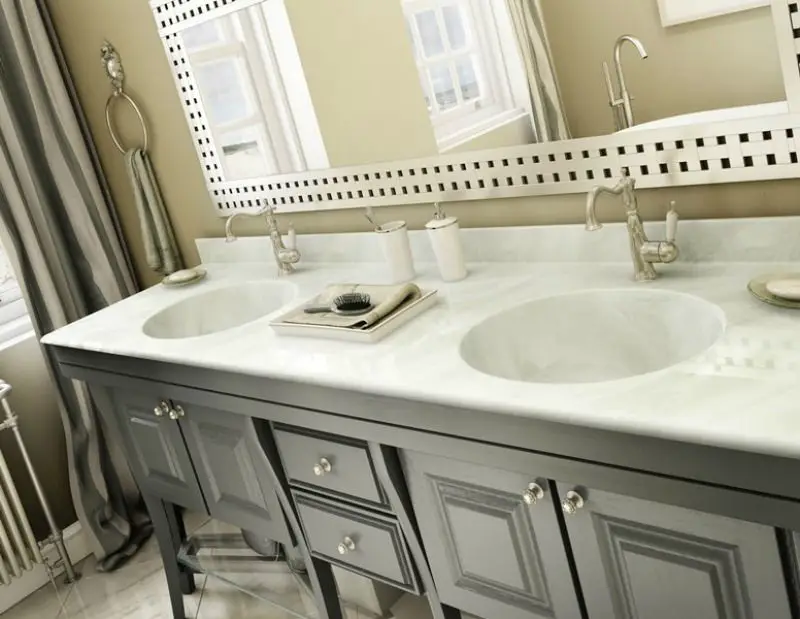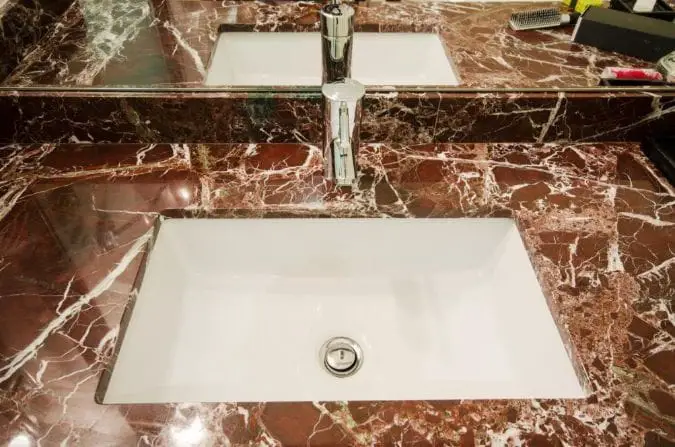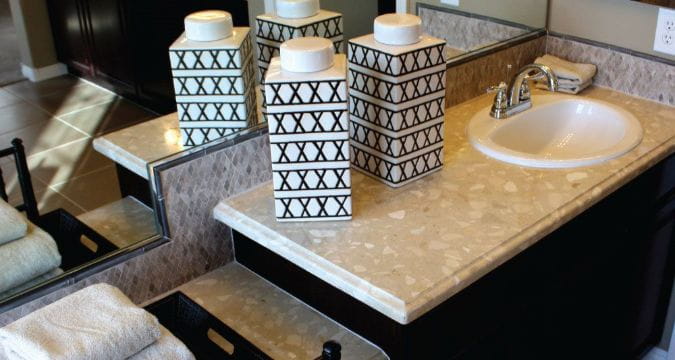Cultured Marble vs Marble:
What's The Difference?
This head-to-head guide clarifies the often confusing comparison of cultured marble vs marble. Is it real marble? How can you tell? All questions and details are answered in-depth below, so let’s dig in!
 Image source: Carstin Brands
Image source: Carstin BrandsOn This Page
1. Cultured Marble vs Marble: Questions, Answers, Comparison
2. Is Cultured Marble Real Marble?
3. What's the difference between marble and cultured marble?
4. How can you tell marble from cultured marble?
5. Care & Cleaning Comparison
6. Cost: Natural Marble vs Cultured Marble
7. Cultured Marble vs Engineered Marble
8. What's the difference between cultured marble and engineered marble?
9. Cultured Marble vs Onyx
10. Conclusion
Cultured Marble vs Marble: Questions, Answers, Comparison
Every homeowner and designer on the planet seems to love the look of marble, and I’m sure you are familiar too. It’s gorgeous but can be a bit tricky to care for, so you’re considering alternatives.
You've likely heard of cultured marble, but it’s not surprising if you don’t know much about it.
Even though it does have extensive use and appeal and could be precisely what you want for your kitchen or bathroom countertops, it simply gets lost among the myriad kitchen countertop options.
The first question most people ask…
Is Cultured Marble Real Marble?
No, cultured marble is not real marble, the natural stone. But it is related. Cultured marble is a man-made material blending pulverized natural marble with synthetic resins and dyes then coated with a clear, hard, protective gel.
So cultured marble contains real marble dust but is not itself natural marble. It is faux marble.
Cultured marble is more closely comparable to Corian and quartz countertops in this regard, although it is still a bit different than these countertop materials.
Related Content:
Cultured Marble vs Corian vs Quartz vs Granite
It’s a versatile material used to make countertops and vanity tops, along with sinks, backsplashes, showers, and bathtubs.
So we now know that cultured marble is not the same as real marble, but that’s not the end of the story.
Looking carefully below at specific pros and cons of cultured marble vs marble, we’ll see many similarities regarding the look, performance, cost, cleaning, maintenance, and repair characteristics. But, of course, differences too.
Here are the key differences, but don’t miss the detailed explanations in the sections below to give you a complete understanding.
What's the difference between marble and cultured marble?
Natural marble is quarried from the earth and considered a high-end, luxury material. Cultured marble is a man-made, budget-friendly surface made to look like marble. Additional differences are:
- Real marble has unique colors, patterns, and a mirror-like shine with visual depth.
- Cultured marble colors mimic marble but look flat in comparison and the gel-coat gloss can look plastic.
- Real marble is more expensive than cultured marble.
- Cultured marble sinks and backsplashes are molded into the countertop. Showers have integrated shelving.
- Cultured marble does not have seams.
- Marble countertops do not have integrated sinks or backsplashes and will have seams except for smaller vanities.
- Both can be scratched, stained, scorched, cracked, or chemically damaged.
- Both have a similar level of care & cleaning requirements, although some specific differences (see below).
- Marble needs sealing; cultured marble does not.
- Both can be repaired to like-new condition
Colors & Patterns: Cultured Marble vs Marble
Some will argue that the look of cultured marble is nearly identical to marble as many cultured marble colors are designed to resemble marble countertops, and it has a glossy finish.
It may be true that cultured marble and real marble can look the same from a distance. Still, even a person without any knowledge of countertop materials will instantly recognize the difference up close.
 Real natural marble countertop: polished Rosso Carpazi
Real natural marble countertop: polished Rosso CarpaziMarble is the essence of luxury, especially white marble, such as Carrara and Calacatta. Designers and homeowners alike love the colors, unique veining, look, and feel of real marble.
Cultured marble is man-made and not considered a luxury countertop material. However, it can present a clean and classic if modest elegance depending on the color and pattern chosen.
Both do share a comparable color palette, though, with predominantly whites, tans, and earth tones, but also black, blue, green, red, and pink colors.
How can you tell real marble from cultured marble?
The most common signs that you have cultured marble and not real marble is that cultured marble countertops will have an integrated sink and backsplash of the same color and pattern, no seams or caulking, a thin edge, and dull gray underside. Additional clues are...
- On natural marble countertops, sinks and backsplashes are separately attached to the marble. Either the sink will sit on top of the marble, or it will be under-mounted with the marble forming an edge around and above the sink.
- Real marble will have grout, or caulking in the joints for sinks and backsplashes.
- Cultured marble has a protective gel-coat that is glossy like polished marble, but it also looks a bit plastic up close, unlike natural marble.
- Marble can be either polished to a gloss or have a matte “honed” finish but never looks plastic.
- Colors and patterns can look similar. However, these will look flat and very consistent on cultured marble versus marble that has depth and variability in the colors and patterns with random veins, etc.
- Cultured marble vanities are all one piece without any seams, grout lines, or caulking.
- Natural marble countertops (depending on slab size) will have seams joining the slabs.
- The edges of cultured marble are usually thin at around ¾” (~2 cm), often with a lip to prevent drips off the edge. Distinctive designs are possible but not common.
- Real marble edges are generally thicker at 1 ¼” (3 cm) and often with fancy designs. Natural marble vanities and countertops do not have a lip at the edge to prevent drips.
- The underside of a cultured marble vs marble countertop is also a key indicator. Cultured marble will be a dull, uniform gray color without any pattern. Marble may look dull on the underside, but the pattern and color will still be visible.
- Cultured marble showers may be one huge molded piece or large wall panels will have very few seams and caulking. Seats and shelves are molded into the wall panels. The shower pan floor is all one molded piece.
- Marble showers are usually made with small tiles with many grout lines on the wall and floor.
Care & Cleaning Comparison
We've learned that cultured marble and real marble are completely different materials.
We recommend these cleaners for best results and value on each surface:
Cultured Marble
- Puracy Cleaner: powerful cleaner, streak-free, biodegradable
- Gel-Gloss Polish: required to protect and maintain the glossy finish coating on cultured marble
Real Marble Countertops
- Stone Care Marble & Granite Cleaner: excellent marble-safe (won't etch) steak-free cleaner
- Stone Care Green Certified Marble Cleaner: a more environmentally-friendly version of the above cleaner.
However, a close look at the cleaning issues of cultured marble vs marble reveals that both have similar weaknesses and share a similar level of required care and maintenance.
So, it's interesting... the time and effort needed to maintain each surface in good condition is the same, but note that specific issues and cleaners vary.
- Both can scratch, stain, chip, and crack under certain circumstances.
- Both are damaged by certain cleaners and chemicals.
- Use only non-abrasive, pH neutral cleaners on both.
- On natural marble, using specific marble cleaners is best. Most common cleaners will dull and etch the marble finish.
- For cleaning cultured marble, the Stone Care Marble Cleaning Spray is a great choice. It's safe, effective, and dries with a streak-free shine. Puracy cleaner is another option.
- The Gel-Gloss Polish for Cultured Marble is a must for protecting the shine and gel coat of cultured marble.
- Sealing marble helps prevent stains (but not etching).
- Cultured marble doesn’t require sealing as the gel coat is non-porous, but stains are still possible mainly from hair and food dyes.
- Marble will take heat much better than cultured marble, which can burn rather quickly.
Learn more about cleaning cultured marble vs. marble:
How To Clean Cultured Marble Countertops & Showers
Cleaning Marble Do's & Don'ts Guide
Repair & Refinishing Options
Repair is possible on both surfaces. However, marble repair procedures are entirely different from cultured marble repair and do not cross over.
- Marble stains, scratches, etch marks, chips, and cracks can almost always be repaired and very often with simple DIY products and procedures.
- DIY repair of damage to the cultured marble gel coat is also possible so long as the gel coat is not completely removed.
- Professional repair to virtually new condition is possible with both materials.
Cost: Natural Marble vs Cultured Marble
Cultured marble countertops and vanities on average are cheaper than natural marble countertops but not exceptionally so in many cases.
- Real marble countertop costs will run from $40 - $200+ per square foot installed but average between $65 - $95/sq. ft.
- Cultured marble countertops range around $40 - $70/sq. ft.
So you can see there is some overlap when comparing cultured marble vs marble prices, but the average marble countertop installation will cost more. Often a lot more.
Marble tile, on the other hand, at $15 - $55/psf installed, can be cheaper than a cultured marble shower or countertop.
Cultured Marble vs Engineered Marble
As if the distinction between cultured marble vs natural marble isn’t confusing enough, we now throw “engineered marble” into the mix. Which, in truth, requires an even finer distinction.
Starting with broad strokes… this comparison shares similarities to both cultured marble vs quartz countertops and cultured marble vs marble that you have just read above.
Meaning engineered marble has characteristics of both real marble and engineered quartz countertops.
 Image Source: PF Surfaces Engineered marble vanity
Image Source: PF Surfaces Engineered marble vanityEngineered marble is a manufactured composite type of countertop material made by blending real marble pieces and fragments of varying size (that have been discarded by marble quarries) within a polyester resin compound along with coloring dyes.
It’s essentially the same manufacturing process as for quartz countertops that use discarded pieces of natural quartz.
But isn’t “cultured marble” also made by blending natural marble and resins?
Yes, and some will say that cultured marble is just a dated term for “engineered marble” but that is false.
Both utilize similar ingredients, but the method used to prepare, mix, and form the individual components into the final countertop product is different.
This means that the look, feel, performance, care, and repair characteristics of cultured marble vs engineered marble are different.
If that still seems confusing, recall above that cultured marble is made with marble dust (not chunks) mixed with resins to form a core which is then encased in a hard gel coat.
Cultured marble also uses a much higher volume of resins vs marble dust. In contrast, engineered marble is mostly composed of crushed natural marble pieces with a much lower volume or ratio of resin.
So let’s break it down…
What's the difference between cultured marble and engineered marble?
Both engineered marble and cultured marble are man-made countertop materials. However, the key difference of cultured marble vs engineered marble is how the product is made which effects how it looks and performs.
Cultured marble is 75% marble dust combined with synthetic materials into a core mold with a hard gel-coat on top. The material is made in layers and not consistent all the way through.
Engineered marble is formed into slabs (95% crushed marble within resin) that are consistent through the full thickness of the slab, just like quartz countertops. A protective gel-coat is not applied.
A few more ways cultured marble is different than engineered marble:
Colors & Design
- Cultured marble countertops are formed with integrated sinks and backsplashes.
- Engineered marble countertops do not have integrated sinks or backsplashes. A hole must be cut in the slab and a sink attached.
- The patterns, colors, and finish of engineered marble look a bit more natural with greater depth and nuance.
Care & Cleaning
- Sealing is not required for cultured marble but may be required for engineered marble (such as Piedrafina brand).
- Both are highly stain-resistant, but both can still be stained or discolored by certain foods, dyes, cleaners, and chemicals.
- Only pH neutral, non-abrasive cleaners should be used on both cultured and engineered marble.
Durability & Repair
- Engineered marble will etch (dull spots in the finish) from acidic foods, drinks, and harsh cleaners just like natural marble. Sometimes etching can be repaired on engineered marble, just like on real marble using the Etch Remover Marble Polishing Powder.
- Cultured marble does not etch in the same manner, but some chemicals can damage it.
- Both can scratch, chip, crack, and burn (although engineered marble will take heat a bit better than cultured marble).
- Most damage to cultured marble can be repaired (as long as the gel coat is intact).
- Damage to engineered marble can be permanent - specifically etching, scratches, burns, and chemical discoloration (pits, chips, and cracks can be filled or repaired). Refinishing may be possible in some cases.
Cost of Cultured Marble vs Engineered Marble
- Costs of cultured marble vs engineered marble can be similar in the range of $40 - $85 per square foot; however, cultured marble is usually the cheaper countertop option.
- Both can be used for shower walls and floors, countertops, and backsplashes.
Most will agree that engineered marble has a more modern and sophisticated look and feel vs cultured marble even though both are very similar in most other categories.
Cultured Marble vs Onyx
Onyx is a natural stone that has virtually the same performance characteristics as real marble.
Onyx looks a bit different than marble in that it is usually a bit translucent. However, care, cleaning, and repair are the same as for natural marble.
Thus, everything you read above about cultured marble vs marble is also true of cultured marble vs onyx.
Oh, and yes… they do also make “cultured onyx” in the same way that cultured marble is made with all the same characteristics except that cultured onyx has a translucent quality to look like real onyx.
Conclusion
From the cultured marble vs marble section, we learned that these surfaces are not the same as many believe.
Cultured marble is a man-made surface, while marble is natural from the earth.
Marble has a more luxurious look and feel and costs more.
Both have similar care and cleaning requirements, which are a bit more involved than other countertop materials.
Both can be repaired to like-new condition in many cases.
Likewise, cultured onyx and engineered marble are similar to cultured marble in their comparison to real marble.
When choosing between cultured marble vs marble, it will likely come down to the needs of your project, whether a kitchen or bathroom countertop or a shower.
If low cost is your goal, then cultured marble is the best choice.
If style, sophistication, luxury, and long-term value is what you want, then go with engineered marble or natural marble.
Additional reading about cultured marble:
- Cultured Marble Buyer's Guide: Countertops, Showers, and Bathtubs
- Cultured Marble vs Corian vs Quartz vs Granite
- Cultured Marble Repair: Polishing, Scratches, Cracks, Burns
- Cleaning Cultured Marble: A Complete Guide


